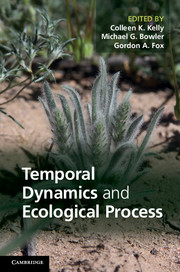Book contents
- Frontmatter
- Contents
- List of Contributors
- 1 Introduction
- Part I Observing temporal processes in nature
- 2 The storage effect: definition and tests in two plant communities
- 3 What temporal processes in trees tell us about competition, community structure and speciation
- 4 Testing the storage effect with long-term observational data
- 5 Seedling herbivory and the temporal niche
- 6 Temporal variation in density dependence in an herbaceous community
- 7 Population and community dynamics in variable environments: the desert annual system
- 8 Temporal niches, ecosystem function and climate change
- Part II Application to specific questions
- Index
- References
8 - Temporal niches, ecosystem function and climate change
Published online by Cambridge University Press: 18 December 2013
- Frontmatter
- Contents
- List of Contributors
- 1 Introduction
- Part I Observing temporal processes in nature
- 2 The storage effect: definition and tests in two plant communities
- 3 What temporal processes in trees tell us about competition, community structure and speciation
- 4 Testing the storage effect with long-term observational data
- 5 Seedling herbivory and the temporal niche
- 6 Temporal variation in density dependence in an herbaceous community
- 7 Population and community dynamics in variable environments: the desert annual system
- 8 Temporal niches, ecosystem function and climate change
- Part II Application to specific questions
- Index
- References
Summary
Introduction
This chapter differs from the main current of this volume – the identification and quantification of coexistence mechanisms associated with temporal niche dynamics – in exploring the ramifications of these processes for ecosystem ecology. The intimate link between niches and ecosystem function has long been recognised, at least in the general sense that more species, representing a greater diversity of ‘life-styles’, make more complete use of available resources and thus achieve higher levels of productivity (e.g. Preston 1948, Odum 1953, MacArthur 1955, May 1975). This broadly stated principle has been unpacked in numerous models that are more specific, for example in resource-ratio niche theory (Tilman 1982) and various forms of spatial niche theories (Loreau 1998). However, the role of temporal niches in the ecosystem context is somewhat less well developed, but critical to understanding ecological responses to climate change.
Two main features characterise worldwide, anthropogenic climate change: a general warming trend that is strongest at low latitudes and weakest at high latitudes, and complex changes in precipitation patterns, currently predicted to include reductions in precipitation at the poleward fringe of the subtropical dry belt at midlatitudes (IPCC 2007, Scheff and Frierson 2012). Both temperature and precipitation shifts, as well as their interactions, have the potential to alter environmental heterogeneity. For example, the onset of spring/summer growing seasons could be advanced (Menzel et al. 2006) and the frequency and amplitude of extreme hydrological events such as drought and flooding increased (Huntington 2006). Both temperature trends and precipitation variability are important factors in structuring temporal niches, for example by functioning as triggers of life-history events (Kelly et al., this volume, Venable and Kimball, this volume) or by controlling competitive interactions through their effects on primary production (Haxeltine and Prentice 1996). Simultaneous changes in seasonal temperature and precipitation patterns may have complex effects on populations and their interactions. Predicting such effects, and their feedbacks on climate, is one of the premiere challenges of earth system science and, in our opinion, cannot be adequately tackled without a more complete understanding of temporal niche dynamics and its role in ecosystem function.
- Type
- Chapter
- Information
- Temporal Dynamics and Ecological Process , pp. 165 - 188Publisher: Cambridge University PressPrint publication year: 2014
References
- 1
- Cited by



